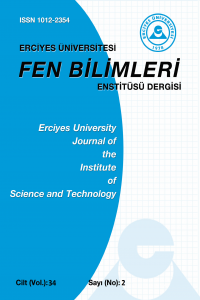Öz
How the data is stored in the memory becomes more
critical when the size of data increases. The programming languages define data
and object types that can be used while programming. Most programming languages
provide more than one data and object type in order to let developers use more
sensitive types which address their needs. Memory management is a key concept
for the data-intensive systems. Also, the NoSQL databases, which are
alternatives to relational database management systems, tend to store the data
on memory and serve the data from memory. In this study, the effect of data and
object types on Java Virtual Machine is evaluated in order to reveal its effect
on Java programming language. Experimental results reveal some key points for developers to use memory more efficiently.
Anahtar Kelimeler
Kaynakça
- [1] P. Sestoft, “Java performance Reducing time and space consumption,” 2005.
- [2] T. Cramer, R. Friedman, T. Miller, D. Seberger, R. Wilson, and M. Wolczko, “Compiling Java just in time,” IEEE Micro, vol. 17, no. 3, pp. 36–43, 1997.
- [3] B. Venners, “Java’s garbage-collected heap,” JavaWorld, 1996.
- [4] T. Ritzau and P. Fritzson, “Decreasing memory overhead in hard real-time garbage collection,” in Second International Conference (EMSOFT 2002), 2002, pp. 213–226.
- [5] L. Prechelt, “An empirical comparison of seven programming languages,” IEEE Comput., vol. 33, no. 10, pp. 23–29, 2000.
- [6] A. W. Appel, “Garbage collection can be faster than stack allocation,” Inf. Process. Lett., vol. 25, no. 4, pp. 275–279, 1987.
- [7] X. Zhang and M. Seltzer, “HBench: JGC-An Application-Specific Benchmark Suite for Evaluating JVM Garbage Collector Performance,” in 6th USENIX Conference on Object-Oriented Technologies and Systems, 2001.
- [8] M. Larose and M. Feeley, “A Compacting Incremental Collector and its Performance in a Production Quality Compiler,” in 1st International Symposium on Memory Management, 1998, pp. 1–9.
- [9] P. A. González, “Applying knowledge modelling and case-based reasoning to software reuse,” IEE Proc. - Softw., vol. 147, no. 5, pp. 169–177, 2000.
- [10] Subham Mittal, “5 Difference between ArrayList and LinkedList in Java with Example,” 2015. [Online]. Available: http://javahungry.blogspot.com/2015/04/difference-between-arraylist-and-linkedlist-in-java-example.html. [Accessed: 11-Oct-2017].
- [11] D. Flanagan, Java In A Nutshell, 2nd ed. California, USA: O’Reilly Media, 2002.
Öz
How the data is stored in the memory becomes more critical when the size of data increases. The programming languages define data and object types that can be used while programming. Most programming languages provide more than one data and object type in order to let developers use more sensitive types which address their needs. Memory management is a key concept for the data-intensive systems. Also, the NoSQL databases, which are alternatives to relational database management systems, tend to store the data in memory and serve the data from memory. In this study, the effect of data and object types on Java Virtual Machine is evaluated in order to reveal its effect on Java programming language. Experimental results reveal some key points for developers to use memory more efficiently.
Anahtar Kelimeler
Kaynakça
- [1] P. Sestoft, “Java performance Reducing time and space consumption,” 2005.
- [2] T. Cramer, R. Friedman, T. Miller, D. Seberger, R. Wilson, and M. Wolczko, “Compiling Java just in time,” IEEE Micro, vol. 17, no. 3, pp. 36–43, 1997.
- [3] B. Venners, “Java’s garbage-collected heap,” JavaWorld, 1996.
- [4] T. Ritzau and P. Fritzson, “Decreasing memory overhead in hard real-time garbage collection,” in Second International Conference (EMSOFT 2002), 2002, pp. 213–226.
- [5] L. Prechelt, “An empirical comparison of seven programming languages,” IEEE Comput., vol. 33, no. 10, pp. 23–29, 2000.
- [6] A. W. Appel, “Garbage collection can be faster than stack allocation,” Inf. Process. Lett., vol. 25, no. 4, pp. 275–279, 1987.
- [7] X. Zhang and M. Seltzer, “HBench: JGC-An Application-Specific Benchmark Suite for Evaluating JVM Garbage Collector Performance,” in 6th USENIX Conference on Object-Oriented Technologies and Systems, 2001.
- [8] M. Larose and M. Feeley, “A Compacting Incremental Collector and its Performance in a Production Quality Compiler,” in 1st International Symposium on Memory Management, 1998, pp. 1–9.
- [9] P. A. González, “Applying knowledge modelling and case-based reasoning to software reuse,” IEE Proc. - Softw., vol. 147, no. 5, pp. 169–177, 2000.
- [10] Subham Mittal, “5 Difference between ArrayList and LinkedList in Java with Example,” 2015. [Online]. Available: http://javahungry.blogspot.com/2015/04/difference-between-arraylist-and-linkedlist-in-java-example.html. [Accessed: 11-Oct-2017].
- [11] D. Flanagan, Java In A Nutshell, 2nd ed. California, USA: O’Reilly Media, 2002.
Ayrıntılar
| Birincil Dil | İngilizce |
|---|---|
| Bölüm | Makale |
| Yazarlar | |
| Yayımlanma Tarihi | 31 Ağustos 2018 |
| Yayımlandığı Sayı | Yıl 2018 Cilt: 34 Sayı: 2 |
Kaynak Göster
✯ Etik kurul izni gerektiren, tüm bilim dallarında yapılan araştırmalar için etik kurul onayı alınmış olmalı, bu onay makalede belirtilmeli ve belgelendirilmelidir.
✯ Etik kurul izni gerektiren araştırmalarda, izinle ilgili bilgilere (kurul adı, tarih ve sayı no) yöntem bölümünde, ayrıca makalenin ilk/son sayfalarından birinde; olgu sunumlarında, bilgilendirilmiş gönüllü olur/onam formunun imzalatıldığına dair bilgiye makalede yer verilmelidir.
✯ Dergi web sayfasında, makalelerde Araştırma ve Yayın Etiğine uyulduğuna dair ifadeye yer verilmelidir.
✯ Dergi web sayfasında, hakem, yazar ve editör için ayrı başlıklar altında etik kurallarla ilgili bilgi verilmelidir.
✯ Dergide ve/veya web sayfasında, ulusal ve uluslararası standartlara atıf yaparak, dergide ve/veya web sayfasında etik ilkeler ayrı başlık altında belirtilmelidir. Örneğin; dergilere gönderilen bilimsel yazılarda, ICMJE (International Committee of Medical Journal Editors) tavsiyeleri ile COPE (Committee on Publication Ethics)’un Editör ve Yazarlar için Uluslararası Standartları dikkate alınmalıdır.
✯ Kullanılan fikir ve sanat eserleri için telif hakları düzenlemelerine riayet edilmesi gerekmektedir.


